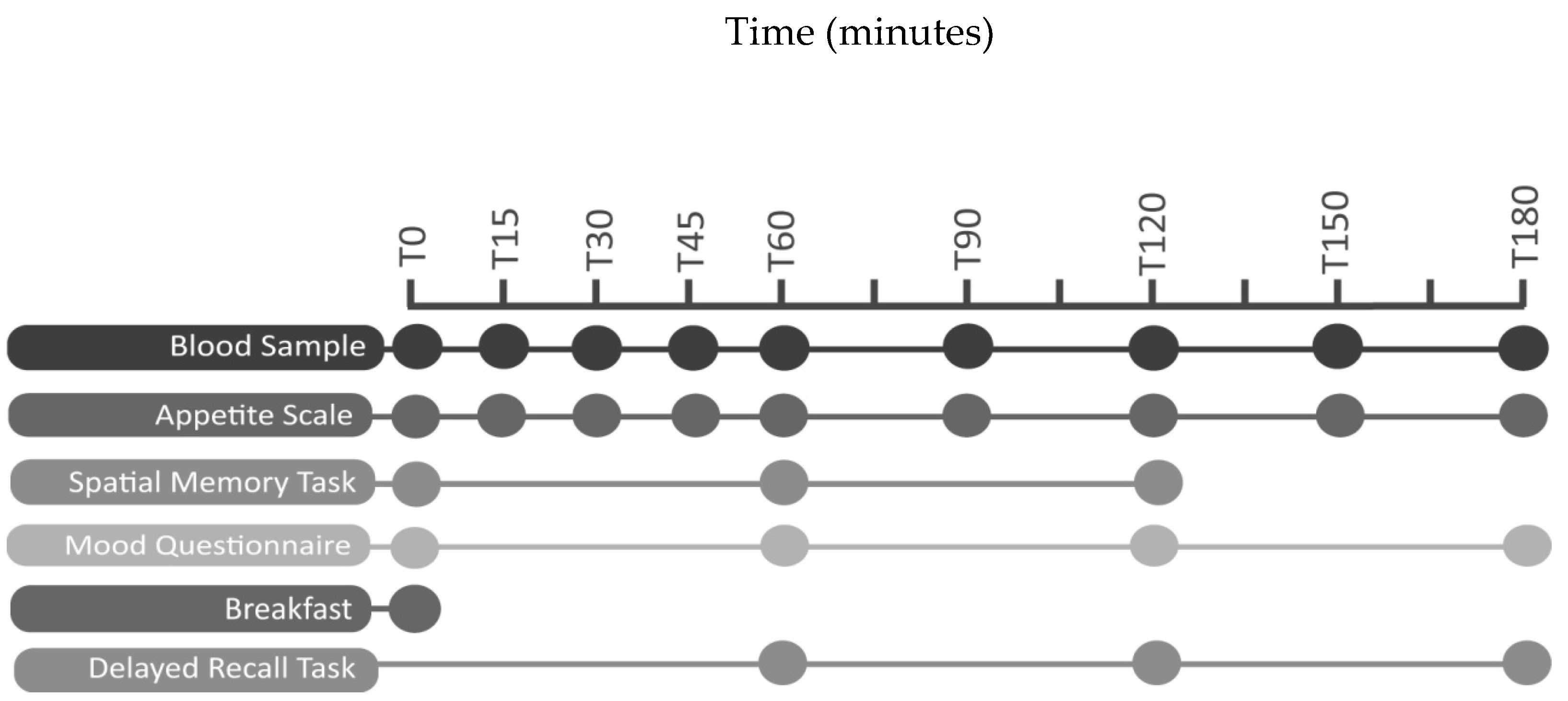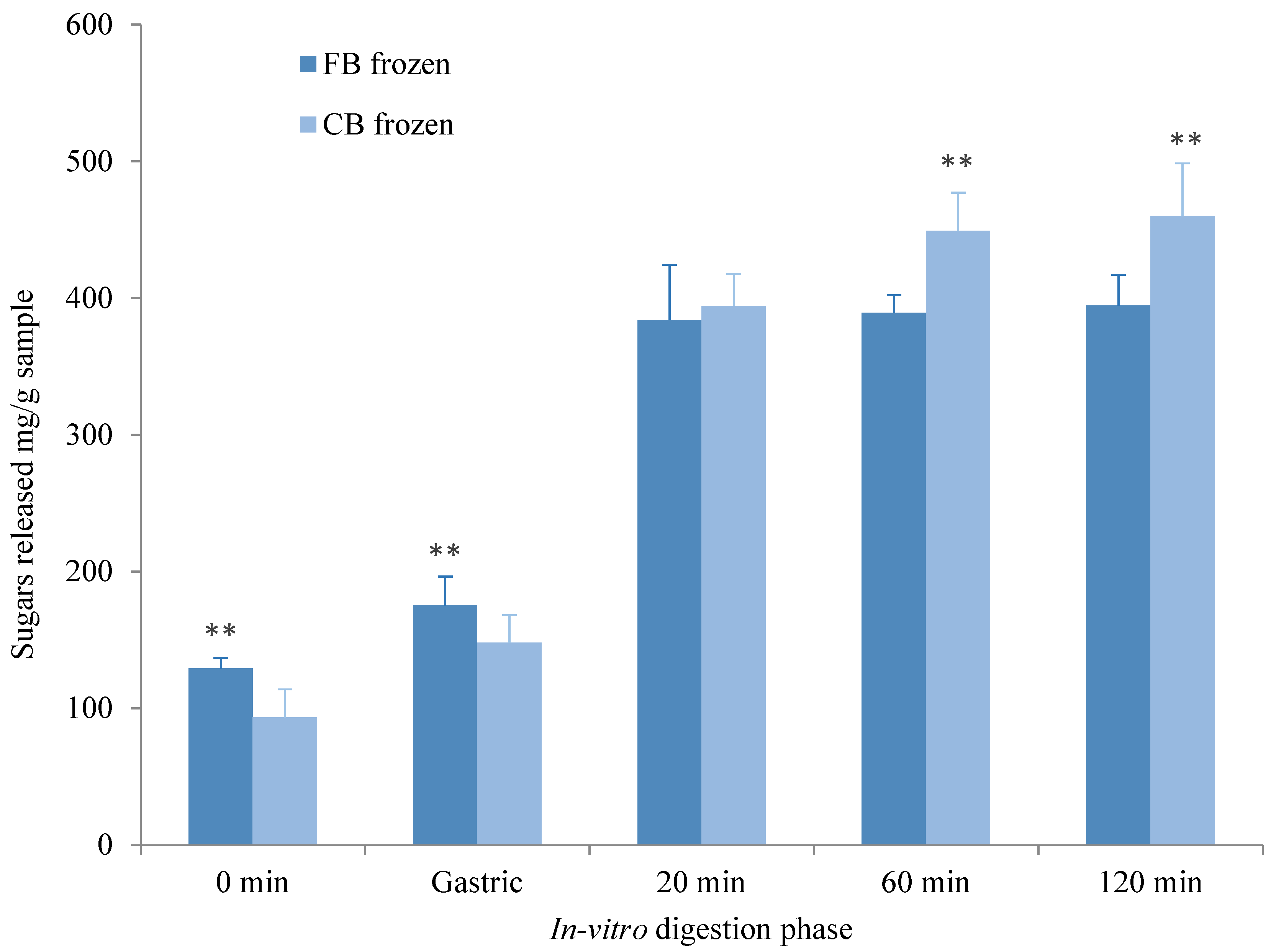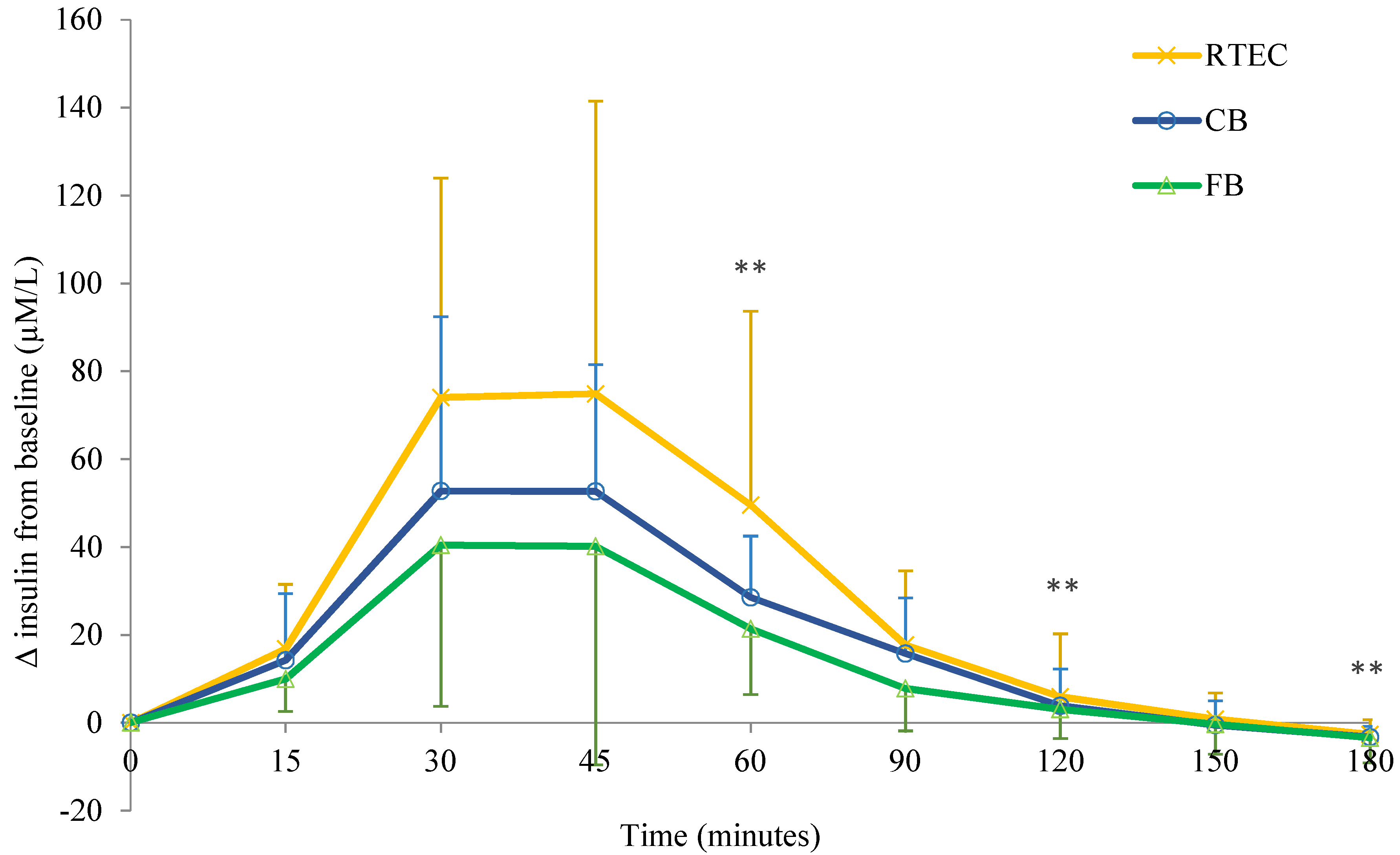The Effects of a Functional Food Breakfast on Gluco-Regulation, Cognitive Performance, Mood, and Satiety in Adults
Abstract
:1. Introduction
2. Materials and Methods
2.1. Studies 1 and 2: Overview
2.2. Studies 1 and 2: Ethics
2.3. Study 1: Breakfast Development
2.4. Study 1: Total Polyphenols and Sugar Release
2.5. Study 1: In Vitro Digestion and Sugar Release
2.6. Study 2: In Vivo Study Design
2.7. Study 2: Participants
2.8. Study 2: Testing Schedule
2.9. Study 2: Test Meals
2.10. Study 2: Blood Samples
2.11. Study 2: Cognition, Mood and Appetite
2.12. Study 2: Power Calculation
2.13. Studies 1 and 2: Statistical Analyses
3. Results
3.1. Study 1: In Vitro Study
3.1.1. Total Polyphenol Content of Muffin Samples
3.1.2. Sugar Release
3.2. Study 2: In Vivo Study
3.2.1. Participant Baseline Characteristics
3.2.2. Glucose Response (GR)
3.2.3. Insulin response (IR)
3.2.4. Cognitive Tests: Map Task and Delayed Recall
3.2.5. Mood, Satiety and Palatability
4. Discussion
5. Conclusions
Author Contributions
Funding
Acknowledgments
Conflicts of Interest
References
- Arai, S. Studies on functional foods in Japan-State of the art. Biosci. Biotechnol. Biochem. 1996, 60, 9–15. [Google Scholar] [CrossRef] [PubMed] [Green Version]
- Zamora-Ros, R.; Knaze, V.; Lujan-Barroso, L.; Romieu, I.; Scalbert, A.; Slimani, N.; Hjartaker, A.; Engeset, D.; Skeie, G.; Overvad, K.; et al. Differences in dietary intakes, food sources and determinants of total flavonoids between Mediterranean and non-Mediterranean countries participating in the European Prospective Investigation into Cancer and Nutrition (EPIC) study. Br. J. Nutr. 2013, 109, 1498–1507. [Google Scholar] [CrossRef] [PubMed]
- McDougall, G.J.; Stewart, D. The inhibitory effects of berry polyphenols on digestive enzymes. Biofactors 2005, 23, 189–195. [Google Scholar] [CrossRef] [PubMed]
- Coe, S.; Ryan, L. The impact of polyphenol rich sources on acute postprandial glycaemia: A systematic review. J. Nutr. Sci. 2016, 5, e24. [Google Scholar] [CrossRef] [PubMed]
- Hanhineva, K.; Torronen, R.; Bondia-Pons, I.; Pekkinen, J.; Kolehmainen, M.; Mykkanan, H.; Poutanen, K. Impact of dietary polyphenols on carbohydrate metabolism. Int. J. Mol. Sci. 2010, 11, 1365–1402. [Google Scholar] [CrossRef]
- Kim, Y.; Keogh, J.B.; Clifton, P.M. Polyphenols and Glycemic Control. Nutrients 2016, 8, 17. [Google Scholar] [CrossRef]
- Törrönen, R.; Kolehmainen, M.; Sarkkinen, E.; Mykkänen, H.; Niskanen, L. Postprandial glucose, insulin, and free fatty acid responses to sucrose consumed with blackcurrants and lingonberries in healthy women. Am. J. Clin. Nutr. 2012, 96, 527–533. [Google Scholar] [CrossRef]
- Törrönen, R.; Sarkkinen, E.; Niskanen, T.; Tapola, N.; Kilpi, K.; Niskanen, L. Postprandial glucose, insulin and glucagon-like peptide 1 responses to sucrose ingested with berries in healthy subjects. Br. J. Nutr. 2012, 107, 1445–1451. [Google Scholar] [CrossRef] [Green Version]
- Törrönen, R.; Sarkkinen, E.; Tapola, N.; Hautaniemi, E.; Kilpi, K.; Niskanen, L. Berries modify the postprandial plasma glucose response to sucrose in healthy subjects. Br. J. Nutr. 2010, 103, 1094–1097. [Google Scholar] [CrossRef] [Green Version]
- Clegg, M.E.; Pratt, M.; Meade, C.M.; Henry, C.J.K. The addition of raspberries and blueberries to a starch-based food does not alter the glycaemic response. Br. J. Nutr. 2011, 106, 335–338. [Google Scholar] [CrossRef]
- Blacker, B.C.; Snyder, S.M.; Eggett, D.L.; Parker, T.L. Consumption of blueberries with a high-carbohydrate, low-fat breakfast decreases postprandial serum markers of oxidation. Br. J. Nutr. 2013, 109, 1670–1677. [Google Scholar] [CrossRef] [PubMed]
- Törrönen, R.; Kolehmainen, M.; Sarkkinen, E.; Poutanen, K.; Mykkänen, H.; Niskanen, L. Berries reduce postprandial insulin responses to wheat and rye breads in healthy women. J. Nutr. 2013, 143, 430–436. [Google Scholar] [CrossRef] [PubMed] [Green Version]
- Anderson, R.A. Chromium and polyphenols from cinnamon improve insulin sensitivity. Proc. Nutr. Soc. 2008, 67, 48–53. [Google Scholar] [CrossRef] [PubMed] [Green Version]
- Coe, S.A.; Clegg, M.; Armengol, M.; Ryan, L. The polyphenol-rich baobab fruit (Adansonia digitata L.) reduces starch digestion and glycemic response in humans. Nutr. Res. 2013, 33, 888–896. [Google Scholar] [CrossRef]
- Coe, S.; Ryan, L. White bread enriched with polyphenol extracts shows no effect on glycemic response or satiety, yet may increase postprandial insulin economy in healthy participants. Nutr. Res. 2015, 36, 193–200. [Google Scholar] [CrossRef]
- Tosh, S.M. Review of human studies investigating the post-prandial blood-glucose lowering ability of oat and barley food products. Eur. J. Clin. Nutr. 2013, 67, 310–317. Available online: http://www.nature.com/ejcn/journal/v67/n4/suppinfo/ejcn201325s1.html (accessed on 20 July 2017). [CrossRef] [Green Version]
- Ryan, L.; Thondre, P.S.; Henry, C.J.K. Oat-based breakfast cereals are a rich source of polyphenols and high in antioxidant potential. J. Food Compos. Anal. 2011, 24, 929–934. [Google Scholar] [CrossRef]
- Thondre, P.S.; Ryan, L.; Henry, C.J.K. Influence of polyphenols on in vitro starch digestibility of oat porridges. Proc. Nutr. Soc. 2011, 70, E138. [Google Scholar] [CrossRef] [Green Version]
- Lamport, D.J.; Dye, L.; Wightman, J.D.; Lawton, C.L. The effects of flavonoid and other polyphenol consumption on cognitive performance: A systematic research review of human experimental and epidemiological studies. Nutr. Aging 2012, 1, 5–25. [Google Scholar] [CrossRef] [Green Version]
- Bell, L.; Lamport, D.J.; Butler, L.T.; Williams, C.M. A review of the cognitive effects observed in humans following acute supplementation with flavonoids, and their associated mechanisms of action. Nutrients 2015, 7, 10290–10306. [Google Scholar] [CrossRef]
- Giacalone, M.; Di Sacco, F.; Traupe, I.; Topini, R.; Forfori, F.; Giunta, F. Antioxidant and neuroprotective properties of blueberry polyphenols: A critical review. Nutr. Neurosci. 2011, 14, 119–125. [Google Scholar] [CrossRef]
- Vauzour, D.; Vafeiadou, K.; Rodriguez-Mateos, A.; Rendeiro, C.; Spencer, J.P.E. The neuroprotective potential of flavonoids: A multiplicity of effects. Genes Nutr. 2008, 3, 115–126. [Google Scholar] [CrossRef] [PubMed] [Green Version]
- Krikorian, R.; Nash, T.A.; Shidler, M.D.; Shukitt-Hale, B.; Joseph, J.A. Concord grape juice supplementation improves memory function in older adults with mild cognitive impairment. Br. J. Nutr. 2010, 103, 730–734. [Google Scholar] [CrossRef] [PubMed] [Green Version]
- Krikorian, R.; Shidler, M.D.; Nash, T.A.; Kalt, W.; Vinqvist-Tymchuk, M.R.; Shukitt-Hale, B.; Joseph, J.A. Blueberry supplementation improves memory in older adults. J. Agric. Food Chem. 2010, 58, 3996–4000. [Google Scholar] [CrossRef] [PubMed] [Green Version]
- Dodd, G.F.; Williams, C.M.; Butler, L.T.; Spencer, J.P.E. The Acute Effects of Flavonoid-Rich Blueberries on Cognitive Function in Healthy Younger and Older Adults. Nutr Healthy Aging. 2019, 5, 119–132. [Google Scholar] [CrossRef] [Green Version]
- Watson, A.W.; Haskell-Ramsay, C.F.; Kennedy, D.O.; Cooney, J.M.; Trower, T.; Scheepens, A. Acute supplementation with blackcurrant extracts modulates cognitive functioning and inhibits monoamine oxidase-B in healthy young adults. J. Funct. Food 2015, 17, 524–539. [Google Scholar] [CrossRef] [Green Version]
- Sies, H.; Stahl, W.; Sevanian, A. Nutritional, dietary and postprandial oxidative stress. J. Nutr. 2005, 135, 969–972. [Google Scholar] [CrossRef]
- Rodrigues, A.S.; Pérez-Gregorio, M.R.; García-Falcón, M.S.; Simal-Gándara, J. Effect of curing and cooking on flavonols and anthocyanins in traditional varieties of onion bulbs. Food Res. Int. 2009, 42, 1331–1336. [Google Scholar] [CrossRef]
- Lan-Pidhainy, X.; Brummer, Y.; Tosh, S.M.; Wolever, T.M.; Wood, P.J. Reducing beta-glucan solubility in oat bran muffins by freeze-thaw treatment attenuates its hypoglycemic effect. Cereal Chem. 2007, 84, 512–517. [Google Scholar] [CrossRef]
- Nilsson, A.; Tovar, J.; Johansson, M.; Radeborg, K.; Bjorck, I. A diet based on multiple functional concepts improves cognitive performance in healthy subjects. Nutr. Metab. 2013, 10, 49. [Google Scholar] [CrossRef] [Green Version]
- Tovar, J.; Nilsson, A.; Johansson, M.; Ekesbo, R.; Aberg, A.M.; Johansson, U.; Bjorck, I. A diet based on multiple functional concepts improves cardiometabolic risk parameters in healthy subjects. Nutr. Metab. 2012, 9, 29. [Google Scholar] [CrossRef] [Green Version]
- Tovar, J.; Johansson, M.; Björck, I. A multifunctional diet improves cardiometabolic-related biomarkers independently of weight changes: An 8-week randomized controlled intervention in healthy overweight and obese subjects. Eur. J. Nutr. 2015. [Google Scholar] [CrossRef] [PubMed]
- Nilsson, A.; Radeborg, K.; Bjorck, I. Effects of differences in postprandial glycaemia on cognitive functions in healthy middle-aged subjects. Eur. J. Clin. Nutr. 2009, 63, 113–120. [Google Scholar] [CrossRef] [PubMed]
- Kennedy, S.; Ryan, L.; Clegg, M.E. Associations between breakfast consumption, attitudes towards breakfast and physical activity in adolescents. Proc. Nutr. Soc. 2015, 74. [Google Scholar] [CrossRef] [Green Version]
- Sharma, P.; Gujral, H.S. Antioxidant and polyphenol oxidase activity of germinated barley and its milling fractions. Food Chem. 2010, 120, 673–678. [Google Scholar] [CrossRef]
- Mishra, S.; Monro, J.; Hedderley, D. Effect of processing on slowly digestible starch and resistant starch in potato. Starch 2008, 60, 500–507. [Google Scholar] [CrossRef]
- Englyst, H.N.; Hudson, G.J. Colorimetric method for routine measurement of dietary fibre as non-starch polysaccharides. A comparison with gas-liquid chromatography. Food Chem. 1987, 24, 63–76. [Google Scholar] [CrossRef]
- Mishra, S.; Monro, J.A. Digestibility of starch fractions in wholegrain rolled oats. J. Cereal Sci. 2009, 50, 61–66. [Google Scholar] [CrossRef]
- Oxford Brookes University. Random Order Generator. Available online: http://psych.brookes.ac.uk/research/order.asp (accessed on 10 August 2014).
- Broadfield, E.; McKeever, T.; Fogarty, A.; Britton, J. Measuring dietary fatty acid intake: Validation of a food-frequency questionnaire against 7 d weighed records. Br. J. Nutr. 2003, 90, 215–220. [Google Scholar] [CrossRef]
- Siahanidou, T.; Margeli, A.; Kappis, A.; Papassotiriou, I.; Mandyla, H. Circulating visfatin levels in healthy preterm infants are independently associated with high-density lipoprotein cholesterol levels and dietary long-chain polyunsaturated fatty acids. Metabolism 2011, 60, 389–393. [Google Scholar] [CrossRef]
- de Jager, C.A.; Dye, L.; de Bruin, E.A.; Butler, L.; Fletcher, J.; Lamport, D.J.; Latulippe, M.E.; Spencer, J.P.E.; Wesnes, K. Criteria for validation and selection of cognitive tests for investigating the effects of foods and nutrients. Nutr. Rev. 2014, 72, 162–179. [Google Scholar] [CrossRef] [PubMed]
- Mahoney, C.R.; Taylor, H.A.; Kanarek, R.B.; Samuel, P. Effect of breakfast composition on cognitive processes in elementary school children. Physiol. Behav. 2005, 85, 635–645. [Google Scholar] [CrossRef] [PubMed] [Green Version]
- Mahoney, C.R.; Taylor, H.A.; Kanarek, R.B. Effect of an afternoon confectionery snack on cognitive processes critical to learning. Physiol. Behav. 2007, 90, 344–352. [Google Scholar] [CrossRef]
- Philippou, E.; Constantinou, M. The influence of glycemic index on cognitive functioning: A systematic review of the evidence. Adv. Nutr. 2014, 5, 119–130. [Google Scholar] [CrossRef] [PubMed] [Green Version]
- Thayer, R.E. The Biopsychology of Mood and Arousal; Oxford University Press: Oxford, UK, 1989. [Google Scholar]
- Hammersley, R.; Reid, M.; Atkin, S.L. How to measure mood in nutrition research. Nutr. Res. Rev. 2014, 27, 284–294. [Google Scholar] [CrossRef] [Green Version]
- Blundell, J.; de Graaf, C.; Hulshof, T.; Jebb, S.; Livingstone, B.; Lluch, A.; Mela, D.; Salah, S.; Schuring, E.; Van Der Knaap, H.; et al. Appetite control: Methodological aspects of the evaluation of foods. Obes. Rev. 2010, 11, 251–270. [Google Scholar] [CrossRef] [Green Version]
- The Food and Agriculture Organization. Carbohydrates in Human Nutrition, a Joint FAO/WHO Report; Rome. 1998. Available online: https://www.who.int/nutrition/publications/nutrientrequirements/9251041148/en/ (accessed on 20 July 2017).
- Riby, L.M. The impact of age and task domain on cognitive performance: A meta-analytic review of the glucose facilitation effect. Brain Impair. 2004, 5, 145–165. [Google Scholar] [CrossRef]
- Public Health England. The Eatwell Guide: Helping you Eat a Healthy, Balanced Diet. 2016. Available online: https://www.gov.uk/government/publications/the-eatwell-guide (accessed on 20 July 2017).
- Rios, L.Y.; Bennett, R.N.; Lazarus, S.A.; Rémésy, C.; Scalbert, A.; Williamson, G. Cocoa procyanidins are stable during gastric transit in humans. Am. J. Clin. Nutr. 2002, 76, 1106–1110. [Google Scholar] [CrossRef] [Green Version]
- Johnson, M.H.; Lucius, A.; Meyer, T.; de Mejia, E.G. Cultivar evaluation and effect of fermentation on antioxidant capacity and in vitro inhibition of alpha-amylase and alpha-glucosidase by highbush blueberry (Vaccinium corombosum). J. Agric. Food Chem. 2011, 59, 8923–8930. [Google Scholar] [CrossRef]
- Ceriello, A. Postprandial hyperglycemia and diabetes complications. Is it time to treat? Diabetes 2005, 54, 1–7. [Google Scholar] [CrossRef] [Green Version]
- Benton, D.; Kallus, K.W.; Schmitt, J.A.J. How should we measure nutrition-induced improvements in memory? Eur. J. Nutr. 2005, 44, 485–498. [Google Scholar] [CrossRef]
- Dikeman, C.L.; Fahey, G.C. Viscosity as related to dietary fiber: A review. Crit. Rev. Food Sci. Nutr. 2006, 46, 649–663. [Google Scholar] [CrossRef] [PubMed]
- Beck, E.J.; Tosh, S.M.; Batterham, M.J.; Tapsell, L.C.; Huang, X.F. Oat beta-glucan increases postprandial cholecystokinin levels, decreases insulin response and extends subjective satiety in overweight subjects. Mol. Nutr. Food Res. 2009, 53, 1343–1351. [Google Scholar] [CrossRef] [PubMed]
- Hammersley, R.; Reid, M.; Duffy, M. How may refined carbohydrates affect satiety and mood? Nutr. Bull. 2007, 32, 61–70. [Google Scholar] [CrossRef]
- Pereira, M.A.; Erickson, E.; McKee, P.; Schrankler, K.; Raatz, S.K.; Lytle, L.A.; Pellegrini, A.D. Breakfast frequency and quality may affect glycemia and appetite in adults and children. J. Nutr. 2011, 141, 163–168. [Google Scholar] [CrossRef] [Green Version]
- Jones, E.K.; Suenram-Lea, S.I.; Wesnes, K.A. Acute ingestion of different macronutrients differentially enhances aspects of memory and attention in healthy young adults. Biol. Psychol. 2012, 89, 477–486. [Google Scholar] [CrossRef] [Green Version]
- Christensen, L.; Redig, C. Effect of meal composition on mood. Behav. Neurosci. 1993, 107, 346–353. [Google Scholar] [CrossRef]
- Probst, A.; Humpeler, S.; Heinzl, H.; Blasche, G.; Ekmekcioglu, C. Short-Term Effect of Macronutrient Composition and Glycemic Index of a Yoghurt Breakfast on Satiety and Mood in Healthy Young Men. Complement. Med. Res. 2012, 19, 247–251. [Google Scholar] [CrossRef]
- Dye, L.; Blundell, J. Functional foods: Psychological and behavioural functions. Br. J. Nutr. 2002, 88, 187–211. [Google Scholar] [CrossRef] [Green Version]




| Unit | RTEC a | CB b | FB b | |
|---|---|---|---|---|
| Serving size | g | 60.0 | 140.0 | 161.8 |
| Serving size (milk) | mL | 180.5 | ||
| Nutrients c | ||||
| Energy | kJ | 1475 | 1456 | 1406 |
| kcal | 353 | 344 | 335 | |
| Protein | g | 10.8 | 11.3 | 11.2 |
| Fat | g | 9.4 | 10.5 | 8.1 |
| Total carbohydrate | g | 53.7 | 52.5 | 58.4 |
| Total sugars | g | 22.6 | 10.6 | 14.1 |
| Total fibre (AOAC) | g | 3.7 | 2.5 | 8.4 |
| Available carbohydrate | g | 50 | 50 | 50 |
| Beta-glucan from oats | g | 1.9 | ||
| Ingredients | ||||
| Weetabix weetos | g | 60 | - | - |
| Scott’s porridge oats | g | - | - | 53 |
| Dr.Oetker baking powder | g | - | 5 | 5 |
| Tesco olive oil | g | - | - | 2.6 |
| Tesco British whole milk | mL | 180.5 | 50.0 | 40.0 |
| Tesco everyday value bananas | g | - | - | 30 |
| Schwartz ground cinnamon | g | - | - | 1.0 |
| Tesco blueberries | g | - | - | 30 |
| Minvita baobab superfruit powder | g | - | - | 1.98 |
| Rowse clear honey | g | - | - | 11 |
| Filippo Berio light olive oil spray | g | - | 0.7 | 0.7 |
| Tesco free range eggs (whites) | g | - | 32 | 30 |
| Allison Strong White Bread Flour | g | - | 57 | - |
| Tesco English unsalted butter | g | - | 8.4 | - |
| Tate & Lyle granulated white sugar | g | - | 3.0 | - |
| Myprotein fructose powder | g | - | 6.81 | - |
| Map | T0 | T60 | T120 | |||||||
| Items | RTEC | CB | FB | RTEC | CB | FB | RTEC | CB | FB | p-value |
| Correct | 18 ± 8 | 19 ± 8 | 17 ± 8 | 20 ± 7 | 20 ± 8 | 18 ± 8 | 20 ± 8 | 20 ± 9 | 19 ± 8 | >0.05 |
| Wrong | 2 ± 2 | 2 ± 2 | 3 ± 2 | 2 ± 2 | 2 ± 2 | 2 ± 2 | 2 ± 2 | 2 ± 2 | 2 ± 2 | >0.05 |
| Blank | 10 ± 6 | 8 ± 6 | 10 ± 7 | 9 ± 6 | 7 ± 6 | 10 ± 6 | 8 ± 6 | 8 ± 7 | 9 ± 6 | >0.05 |
| Recall | T60 | T120 | T180 | |||||||
| RTEC | CB | FB | RTEC | CB | FB | RTEC | CB | FB | p-value | |
| Correct | 13 ± 3 | 13 ± 5 | 13 ± 5 | 12 ± 5 | 13 ± 5 | 12 ± 6 | 16 ± 5 | 15 ± 5 | 15 ± 4 | >0.05 |
| Wrong | 0 ± 0 | 0 ± 1 | 0 ± 1 | 0 ± 1 | 0 ± 0 | 0 ± 1 | 0 ± 0 | 0 ± 1 | 0 ± 1 | >0.05 |
| Blank | 17 ± 4 | 16 ± 6 | 18 ± 5 | 18 ± 4 | 15 ± 6 | 18 ± 6 | 14 ± 5 | 14 ± 6 | 15 ± 4 | >0.05 |
© 2020 by the authors. Licensee MDPI, Basel, Switzerland. This article is an open access article distributed under the terms and conditions of the Creative Commons Attribution (CC BY) license (http://creativecommons.org/licenses/by/4.0/).
Share and Cite
Kennedy, S.J.; Ryan, L.; Clegg, M.E. The Effects of a Functional Food Breakfast on Gluco-Regulation, Cognitive Performance, Mood, and Satiety in Adults. Nutrients 2020, 12, 2974. https://doi.org/10.3390/nu12102974
Kennedy SJ, Ryan L, Clegg ME. The Effects of a Functional Food Breakfast on Gluco-Regulation, Cognitive Performance, Mood, and Satiety in Adults. Nutrients. 2020; 12(10):2974. https://doi.org/10.3390/nu12102974
Chicago/Turabian StyleKennedy, Sarah J., Lisa Ryan, and Miriam E. Clegg. 2020. "The Effects of a Functional Food Breakfast on Gluco-Regulation, Cognitive Performance, Mood, and Satiety in Adults" Nutrients 12, no. 10: 2974. https://doi.org/10.3390/nu12102974







